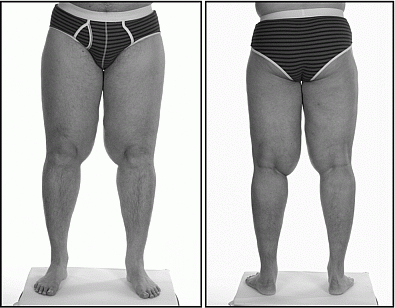SFEBES2012 Poster Presentations Clinical practice/governance and case reports (90 abstracts)
Tricky sums: The endocrine manifestations of hypoalbuminaemia
Devesh Sennik 1 , Hisham Elhag Ali 1 , Manohar Kenchaiah 1 , Chaminda Garusinghe 1 , Sahar Mansour 2 , Peter Mortimer 3 & Gul Bano 1
1The Thomas Addison Endocrine Unit, St George's Healthcare NHS Trust, Tooting, United Kingdom; 2Clinical Genetics, St George's Healthcare NHS Trust, Tooting, United Kingdom; 3Lymphoedema Department, St George's Healthcare NHS Trust, Tooting, United Kingdom.
A 41 year old man was initially referred to lymphoedema clinic. He had leg swelling of 10 years duration but was otherwise fit and well. Examination revealed marked lipohypertrophy affecting his thighs bilaterally. There was no oedema and his distal lower limbs were normal. MRI investigation confirmed focal lipohypertrophy. Biochemical investigation revealed a very low albumin of <10 g/l, a low calcium of 1.96 mmol/l and hyperlipidaemia (cholesterol 9.3 mmol/l, LDL 6.4 mmol/l) with an elevated HDL of 2.37 mmol/l. A normal total protein level was noted and further tests were undertaken to establish if other plasma proteins were being upregulated to compensate for the low albumin. Immunoglobulin and C3 complement levels were slightly increased but a marked eightfold increase in α-fetoprotein (AFP), which is an evolutionary related protein, was discovered. Baseline endocrine tests performed showed some abnormal results because of albumin’s function in the transport of hormones. He had elevated testosterone of 46.2 nmol/l, an elevated SHBG of 91nmol/l and normal LH and FSH levels. High levels of total testosterone compensate for the lack of albumin-bound testosterone. This maintains a near-normal bioavailable testosterone. The compensatory increase in other plasma proteins appeared to be maintaining some hormone levels. Vitamin D levels were 114 nmol/l with a normal PTH of 3.1 pmol/l. TSH, free T4, IGF-1 and Prolactin levels were normal. Thyroid hormone levels were maintained by increased alpha-1 antitrypsin and transthyretin levels. Vitamin D levels are likely being maintained (despite lipohypertrophy) by increased vitamin D binding protein (VDBP). The normal PTH suggests that the levels of unbound calcium are normal. Genetic testing for the known mutations causing congenital analbuminaemia was negative. To our knowledge a case of compensatory increase in AFP in cases of analbuminaemia has not been reported before. Clinicians should be aware of the effect of albumin on endocrine testing and the interpretation of results.

Lipohypertrophy involving legs
Declaration of interest: There is no conflict of interest that could be perceived as prejudicing the impartiality of the research reported.
Funding: No specific grant from any funding agency in the public, commercial or not-for-profit sector.
 }
}



